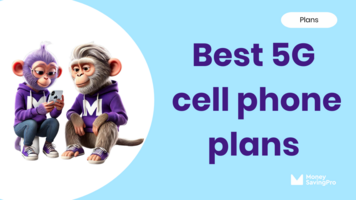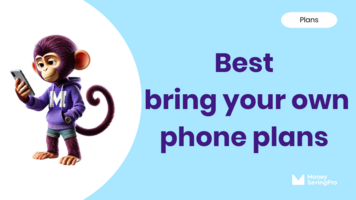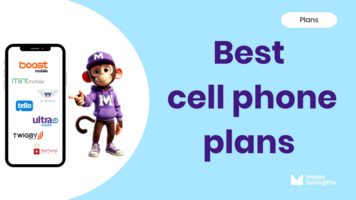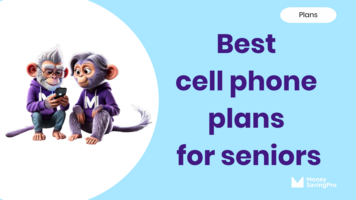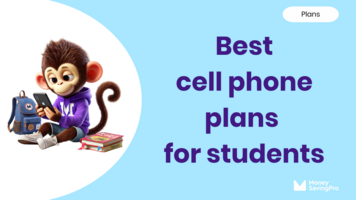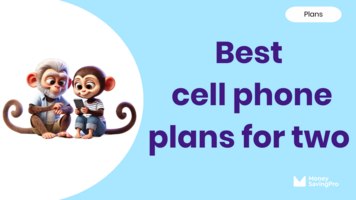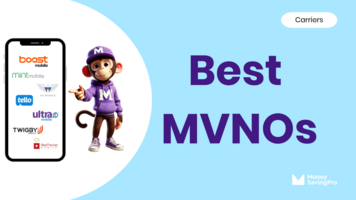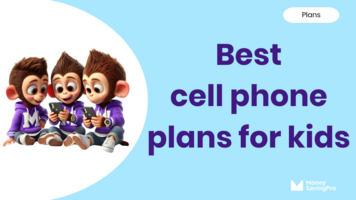
Ever get fed up with the high cost of wireless service? You're not the only one!
Even if you cut costs by avoiding expensive unlimited plans, you may still need a more affordable option. How does free sound?
If you fall within certain low-income guidelines, you may qualify for a free government cell phone and service through a government program called Lifeline.
This option is a great solution if:
- You don't need tons of data
- You're a senior citizen
- You need a phone for work or job searching
- You need a phone in case of things like car problems or medical emergencies
UPDATE: The Affordable Connectivity Program (ACP) will run out of funding in April 2024. To qualify for assistance, you must complete a separate application for Lifeline.
In this guide, you'll find everything you need to know about this free cell phone program and how to get started.
Who Qualifies?
While there may be minor differences from state to state, Lifeline is a federal government assistance program, so qualifications are universal for the most part.
There are two ways to qualify for the Lifeline assistance program.
The most common way is participation in one of these government programs:
- Medicaid
- Supplemental Nutrition Assistance Program (or SNAP, formerly known as Food Stamps)
- Section 8 (Federal Public Housing Assistance)
- Supplemental Security Income (SSI)
- Veterans or Survivors Pension Benefits
- Bureau of Indian Affairs (BIA) General Assistance
- Tribal Temporary Assistance for Needy Families (TTANF)
- Tribal Head Start (must meet income thresholds)
- Food Distribution Program on Indian Reservations (FDPIR)
The second way to qualify is by your income.
Most states require that your total household income is less than 135% of federal poverty guidelines. So, for most states, 2018 income for a two-person household would need to be at or below $22,221 ($16,460 multiplied by 1.35).
Income levels vary by state, with a few states allowing for higher income:
- California - 218% of federal poverty guidelines
- Nevada - 175%
- Florida, Kansas, Michigan, New Jersey, Ohio, Rhode Island, Texas - 150%
It's best to check with Lifeline carriers in your state to confirm income level requirements.
How to Signup
Signing up for free cell phone service through the Lifeline program is simple:
- Find a provider in your state: Check out the list below of all Lifeline carriers, along with the states in which they operate.
- Review the information on each carrier's website: It's important to look at what each company has to offer Lifeline customers. Cell phones and service plans vary from carrier to carrier.
- Enroll online or by phone: The most convenient way to enroll in Lifeline's free cell phone offer is to sign up on the provider's website. You can typically choose to call instead, however it's much easier to enroll online so that you can quickly and easily upload any required documentation.
If possible, enroll in Lifeline via a qualifying program rather than by income requirements. Verification is automated if you participate in a qualifying program, making the process faster and easier. If you register based upon your income level you may be required to provide proofs. Arrival time for your phone may range from a week to several weeks.
Free Lifeline Carriers
There are several free government cell phone companies. SafeLink and Assurance Wireless are the two major providers involved in the Lifeline free cell phone program. Other options exist in some states, however, so be sure to look at all of your options before making a decision.
- SafeLink Wireless – SafeLink is operated by TracFone Wireless and is the biggest and oldest Lifeline provider. SafeLink provides service in Alabama, Arkansas, Arizona, California, Connecticut, Delaware, Florida, Georgia, Hawaii, Illinois, Indiana, Iowa, Kansas, Kentucky, Louisiana, Maine, Maryland, Massachusetts, Michigan, Mississippi, Missouri, Nevada, New Hampshire, New Jersey, New Mexico, New York, North Carolina, Ohio, Pennsylvania, Puerto Rico, Rhode Island, South Carolina, Tennessee, Texas, Utah, Virginia, Washington, Washington D.C., West Virginia, and Wisconsin.
- Assurance Wireless – Run by Sprint Nextel, Assurance operates in Alabama, Arizona, Arkansas, California, Colorado, Connecticut, Delaware, Florida, Georgia, Idaho, Indiana, Iowa, Kansas, Kentucky, Louisiana, Maine, Maryland, Massachusetts, Michigan, Minnesota, Mississippi, Missouri, Nevada, New Hampshire, New Jersey, New Mexico, New York, North Carolina, Ohio, Oregon, Pennsylvania, Rhode Island, South Carolina, Tennessee, Texas, Utah, Virginia, Washington, Washington D.C., West Virginia, and Wisconsin.
- Q Link Wireless – T-Mobile network powers Q Link Wireless. This carrier services Arkansas, Arizona, Colorado, Georgia, Idaho, Indiana, Iowa, Kansas, Kentucky, Louisiana, Maine, Maryland, Michigan, Minnesota, Missouri, Nevada, Ohio, Oklahoma, Pennsylvania, Puerto Rico, Rhode Island, South Carolina, Texas, Utah, Vermont, Washington, West Virginia, and Wisconsin.
- Access Wireless – Another T-Mobile network provider, Access is available in Alabama, Arkansas, Arizona, California, Colorado, Connecticut, Delaware, Florida, Georgia, Illinois, Indiana, Iowa, Kansas, Kentucky, Louisiana, Maryland, Michigan, Minnesota, Mississippi, Missouri, New Hampshire, Nevada, New York, North Carolina, Ohio, Rhode Island, South Carolina, Tennessee, Texas, Utah, Virginia, Washington, Washington D.C., Wisconsin, and West Virginia.
- Life Wireless – This Lifeline carrier runs on the AT&T network. It operates in Arizona, Arkansas, California, Colorado, Connecticut, Georgia, Illinois, Indiana, Iowa, Kentucky, Kansas, Louisiana, Maine, Maryland, Michigan, Minnesota, Missouri, Nevada, North Dakota, Ohio, Oklahoma, Pennsylvania, Puerto Rico, Rhode Island, South Carolina, Texas, Utah, Washington, West Virginia, and Wisconsin.
- Assist Wireless – This provider operates on the T-Mobile network. Assist Wireless only services a handful of states - Arkansas, Maryland, Missouri, and Oklahoma.
- enTouch Wireless – enTouch, a Verizon Wireless free government phone provider, is available in Arizona, Arkansas, California, Colorado, Georgia, Hawaii, Idaho, Indiana, Iowa, Kansas, Kentucky, Louisiana, Maryland, Michigan, Minnesota, Mississippi, Missouri, Nebraska, Nevada, North Dakota, Ohio, Oklahoma, Oregon, Pennsylvania, Puerto Rico, Rhode Island, South Carolina, South Dakota, Texas, Washington, West Virginia, Wisconsin, and Wyoming.
Free Program Includes
There are no bills, no credit checks, and no fees ever to participate in this free program. Most Lifeline carriers offer the following:
- Free monthly minutes
- Free nationwide calling
- Free monthly data (some providers)
- Ability to connect to Wi-Fi
- Free voicemail
- Caller ID & three-way calling
- 911 & 411 calls
Each provider offers a slightly different package, with some carriers offering multiple options and others requiring an upgrade.
For example, SafeLink gives you 350 minutes, unlimited text messages, and 500 MB of data each month; however, you can purchase more minutes and data if you choose.
Other carriers, like enTouch, provide minutes and text messages but no data (except in California, where you get 500 MB of data).
Can You Bring Your Own Phone to Lifeline?
In some cases, yes, you can use your own device. Once you choose a carrier, check their website to see what their requirements are for bringing your own phone.
If not, most Lifeline carriers now provide customers with a basic smartphone.
Cheap Phone Plans
What can you do if you're on a tight budget and don't qualify for the Lifeline free cell phone program? Or maybe you do qualify, but you need more data than the free phone service provides.
Fortunately, you still have plenty of options for affordable mobile service. The best way to save money is to get a cheap cell phone plan through one of the best MVNOs, or Mobile Virtual Network Operators.
MVNOs like Twigby Mobile, Mint Mobile, and Tello offer custom plans that allow you to only pay for what you actually need. Plans start as low as $10 per month, and you can bring your own device as long as it's compatible with the network.
Benefits of MVNOs include:
- No contracts
- Buy only the minutes, texts, and data you need
- Keep your own device
- Keep your phone number
- Great coverage on one or more of the big networks
If you're ready to consider this cost-saving move, compare cell phone plans to help you make your choice.
Recap
It's worth noting that if you do qualify for Lifeline, you are permitted one phone line per household.
UPDATE: The Affordable Connectivity Program (ACP) will run out of funding in April 2024. To qualify for assistance, you must complete a separate application for Lifeline.
Whether you take advantage of a free cell phone through the government or you use an MVNO to get a cheap cell phone plan, there's no reason to sweat it out every month over your mobile service bill.
There's something for everyone when it comes to affordable phone service.
